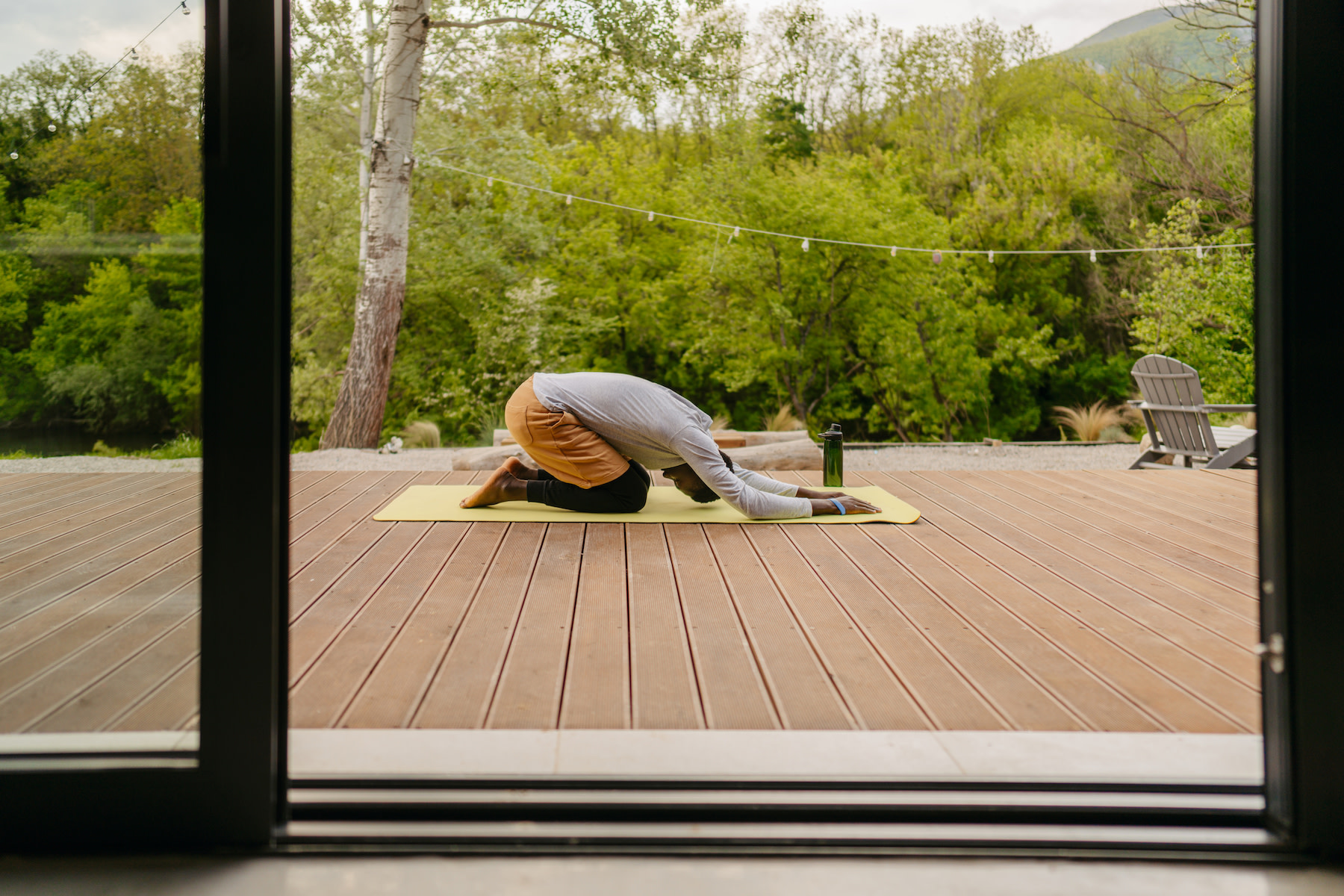
You Deserve a Moment of Relaxation. These 7 Yoga Poses Can Help Give You That
It's time to take a deep breath—and sink into these postures.
By Ingrid Yang•
How Yoga Helps You Relax
What Type of Yoga Should You Practice for Relaxation?
Yoga for Relaxation: 7 Poses to Try
Integrating Yoga into Your Routine for Maximum Relaxation
In today’s world, finding a zen moment can be a challenge. Enter yoga, which can serve as a gateway to gaining some inner peace. But even the most experienced yoga practitioner may wonder: Which postures and practices tend to have the greatest calming effect?
Here, we’ll dive into a selection of yoga poses specifically curated to alleviate stress and foster a state of deep relaxation. We’ll also highlight why certain styles of yoga (think: Yin and restorative yoga) can help you access a serene state of mind.
How Yoga Helps You Relax
Yoga is more than just a series of poses; it's a holistic practice that can benefit your mind, body, and spirit. Physically, yoga helps release tension in your muscles, improving your flexibility and easing discomfort. The poses, coupled with mindful breathing, promote circulation, aiding in the reduction of physical stress and fatigue.
Mentally, yoga encourages focus and concentration, steering your mind away from daily stressors and into the present moment. The mindfulness aspects of yoga can help reduce mental strain and promote a sense of peace and inner-calm.
Emotionally, yoga supports your mood by helping regulate your body's stress response. Yogic deep breathing techniques, known as pranayama, stimulate your parasympathetic nervous system, which is responsible for your body's 'rest and digest' state. These breathing patterns can also help reduce feelings of anxiety or uneasiness.
"Yoga was essential to my healing journey after the traumatic loss of my best friend to gun violence,” says Peloton instructor Chelsea Jackson Roberts. “Today, yoga reminds me to slow down, take a deep breath, and to be present.”
Scientific research has continually backed these benefits. A 2017 study published in Frontiers in Human Neuroscience of 38 participants on a three-month yoga retreat found that a regular yoga and meditation practice led to increased stress resilience, decreased anxiety and depression, and lower cortisol levels.
What Type of Yoga Should You Practice for Relaxation?
If you’re seeking relaxation through yoga, consider trying a Yin or restorative yoga class.
Yin Yoga
“Yin yoga focuses on the connective tissue and joints, using breath and movement to release deeper in the stretch,” Chelsea says. This slow-paced style of yoga involves holding poses for longer periods of time, usually three to five minutes. It targets your deep connective tissues and helps you release tension throughout your body. Plus, the prolonged holds also offer a meditative component.
Restorative Yoga
“Restorative yoga uses props like blankets and bolsters to support the body to rest and restore,” Chelsea says. As the name suggests, this type of yoga is about restoring your body and mind. It often uses props, such as bolsters, blankets, and blocks, to support your body in various poses, allowing for complete relaxation and release.

Peloton App
Access thousands of classes with no equipment needed.
While Yin and restorative yoga are well-known for their calming effects, any type of yoga can offer you a pathway to relaxation. Even if you’re moving through a fast-paced power flow, you’re still tapping into your breath. The act of focusing on your breath and moving through poses can ease mental clutter and reduce stress, helping you access your parasympathetic relaxation system.
Yoga for Relaxation: 7 Poses to Try
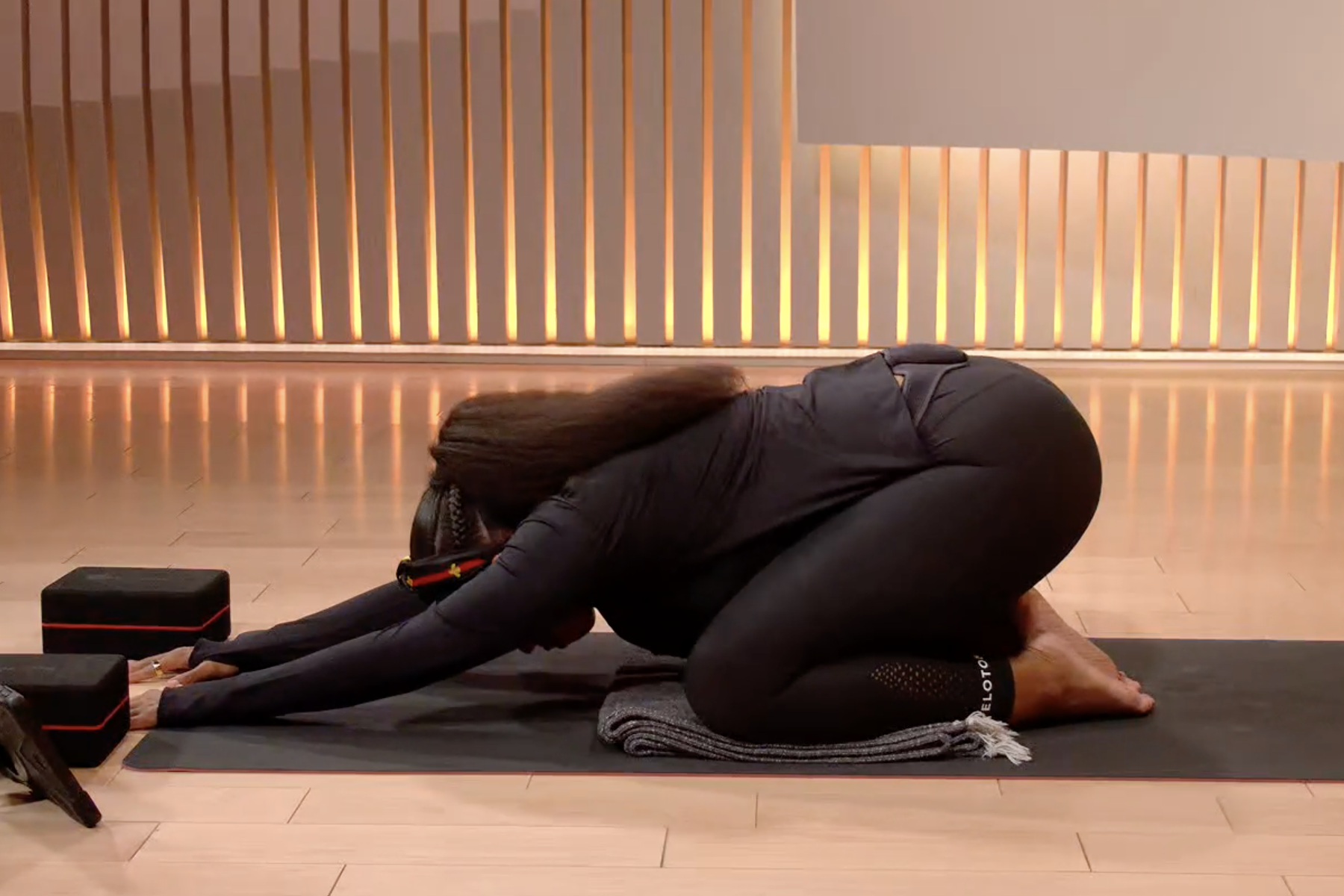
This pose helps release tension in your back and shoulders. “Child's Pose allows me to pause and turn inward because of the positioning of the body,” Chelsea says.
Kneel on the mat. Bring your big toes to touch. Sit back on your heels.
On an inhale, separate your knees to be wider than your hips. Your thighs should form a V-shape.
On an exhale, lay your torso down between your thighs. Bring your forehead to touch the mat.
Extend your arms forward with your palms facing down. You can also place your arms alongside your body with your palms facing up.
Stay here for five to 10 breath cycles.
For additional comfort, you can opt to place a bolster under your torso. If you have neck discomfort, position a folded towel under your forehead or turn your head to one side.
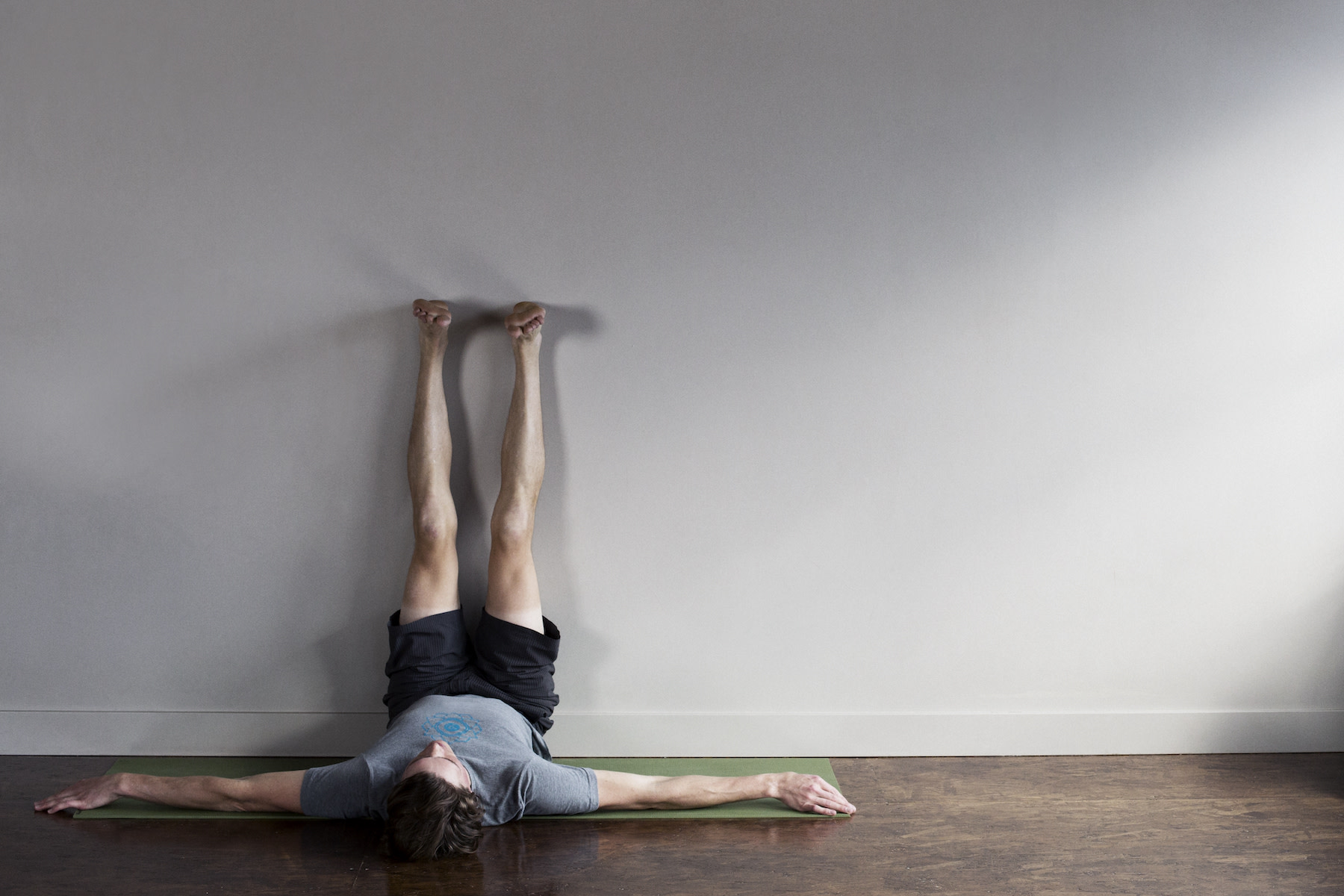
GibsonPictures/E+ via Getty Images
This gentle inversion relieves tension in your lower body and helps calm your nervous system.
Sit on the floor with the right side of your body against a wall.
Swing your legs up the wall as you lay down on your back. Your glutes can be positioned against the wall or a few inches away. Maintain straight legs.
For an additional hamstring stretch, gently push your heels against the wall.
Rest your arms at your sides.
Relax here for five to 10 breath cycles.
For added support, place a bolster under your lower back or a rolled towel under your neck.
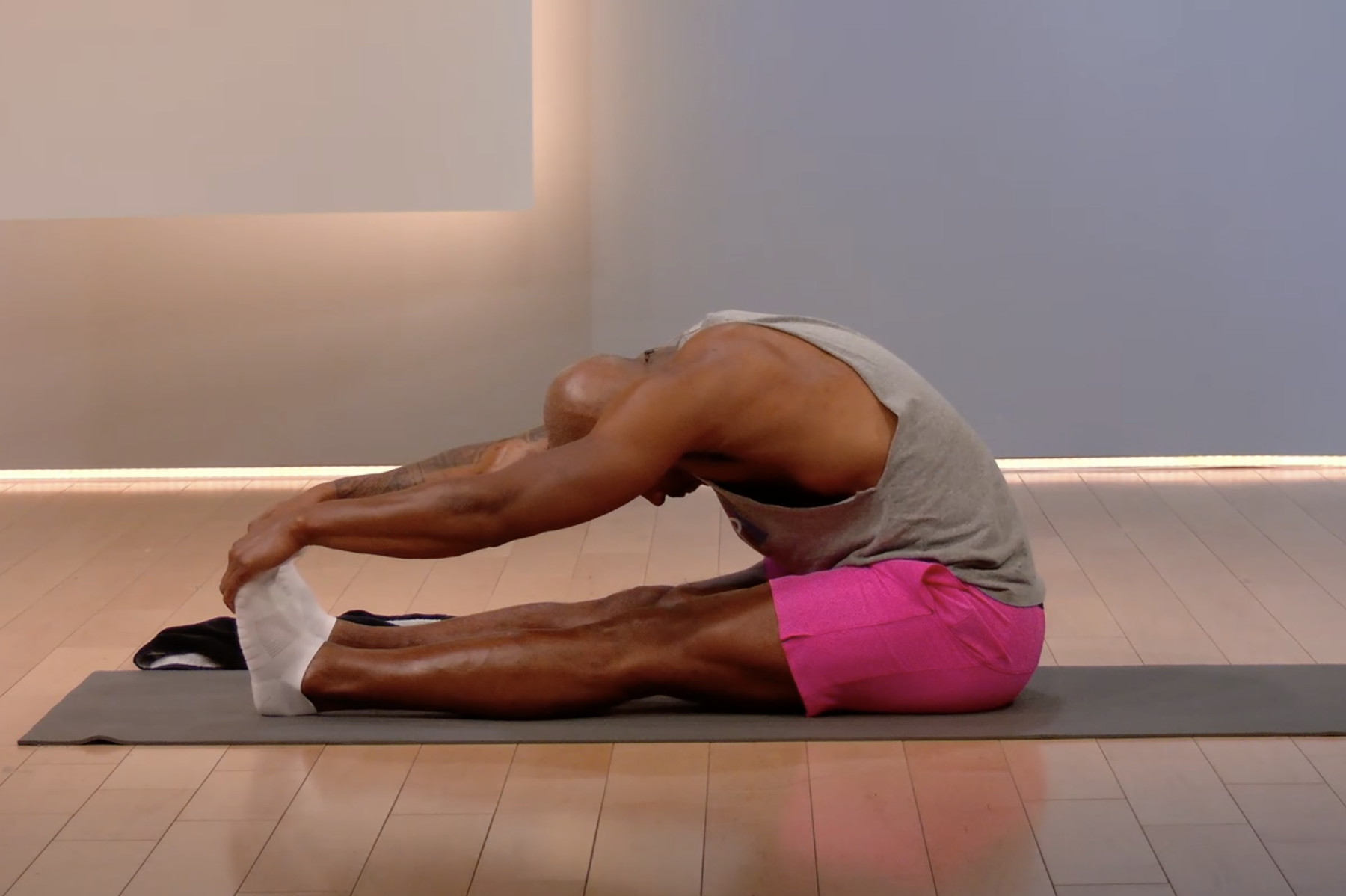
3. Seated Forward Bend (Paschimottanasana)
This pose helps calm your mind and stretches your spine and hamstrings.
Sit with your legs extended straight in front of you.
On an inhale, raise your arms overhead. On an exhale, hinge at your hips to fold forward.
If your flexibility allows for it, reach for your feet—or let your hands fall at a comfortable position on your legs. To extend your reach, wrap a yoga strap around your feet and hold onto it. Avoid straining yourself with your hand positioning. To ease tension in your lower back, bend your knees slightly.

4. Cat-Cow Stretch (Marjaryasana-Bitilasana)
This flowing movement soothes your spine and helps release tension in your torso.
Start on your hands and knees in a tabletop position. If you have joint sensitivity, place a folded blanket under your knees or wrists.
On an inhale, arch your back and look up, coming into Cow Pose.
On an exhale, round your back and tuck your chin, coming into Cat Pose.
Continue through this cycle for at least five rounds, elongating your breath with each movement. Close your eyes to enhance proprioception and internal focus.

5. Supine Bound Angle Pose (Supta Baddha Konasana)
This pose opens your hips and relaxes your abdominal area, promoting ease through your core and lower body.
Begin by lying on your back.
Bring the soles of your feet together. Let your knees fall open to either side. To reduce the strain on your hips, place pillows or folded blankets under your knees. For deeper relaxation, place a weighted blanket over your abdomen.
Place your arms comfortably beside you with your palms facing up.
Hold here for five to 10 breath cycles.

6. Supine Twist (Supta Matsyendrasana)
This gentle twist helps release tension in your spine and calms your nervous system.
Lie on your back. Bring your knees into your chest.
Extend your arms out to the sides at shoulder height.
Slowly lower your knees to the right side while turning your head to the left. Place a cushion or block between your knees for better alignment and less strain on your lower body.
Hold for three to five breath cycles. Switch sides and repeat.
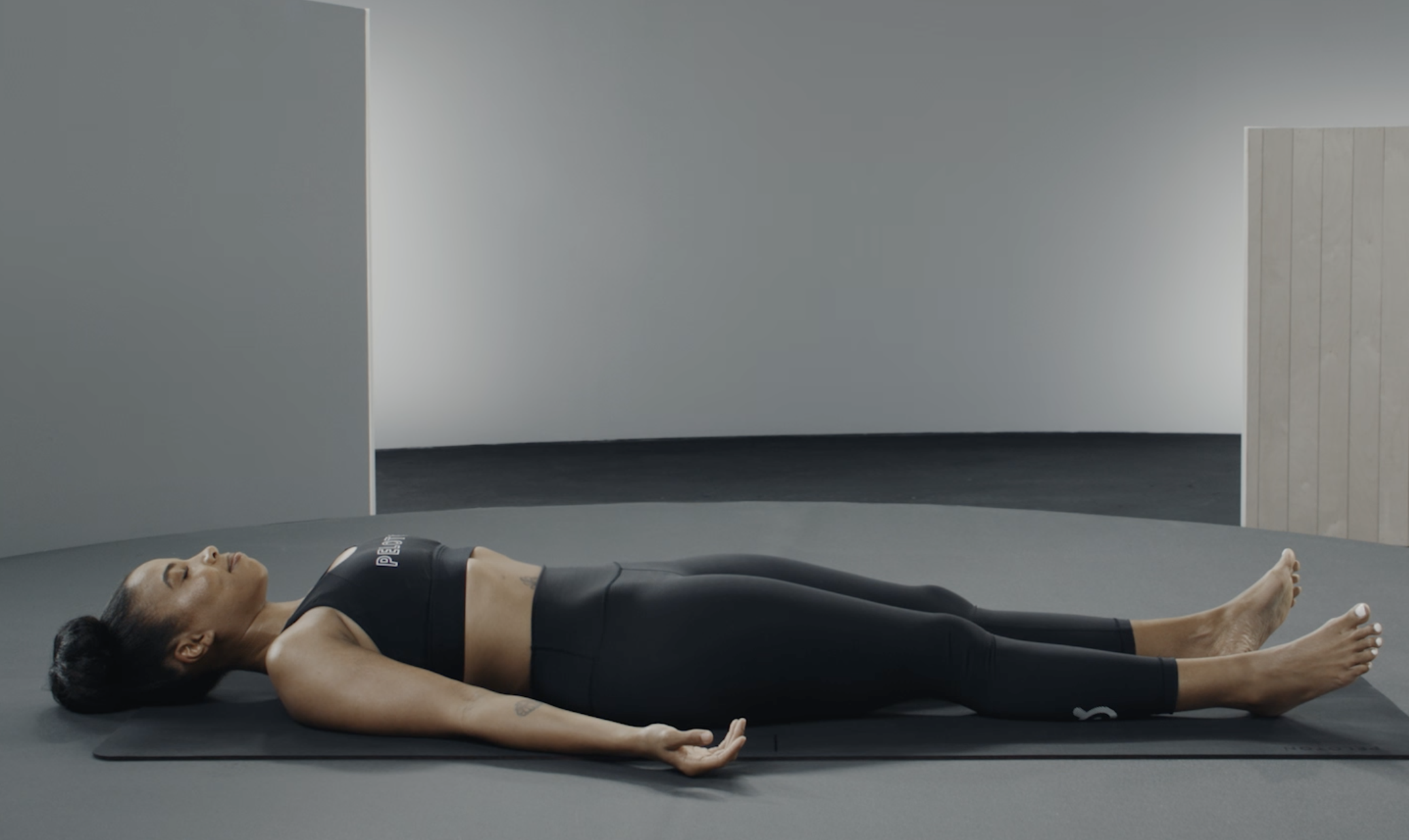
Ideal for deep relaxation and stress relief, this pose allows your body and mind to absorb the benefits of your practice. “[It’s the] ultimate rest posture, typically done at the end of a yoga practice,” Chelsea says. “Never skip Savasana because it is the perfect way to absorb the benefits of the practice.”
Lie flat on your back, with your arms relaxed at your sides and your palms facing up.
Let your feet fall open.
Close your eyes, let go of your breath and allow yourself to completely relax.
For additional comfort, place a rolled-up blanket under your knees or a small pillow under your head. For lower back issues, elevate your legs slightly with a bolster. For sensory grounding, cover your eyes with an eye pillow or folded towel.
Integrating Yoga into Your Routine for Maximum Relaxation
To fully reap the benefits of yoga for relaxation, Chelsea recommends “starting off with small increments of time; don't try to do this perfectly because it will create more discomfort and stress.” Maintaining a regular practice, even if it's just for a few minutes each day, can lead to increased awareness, presence, and connection in your daily life.
Remember: Yoga is a personal experience, so modify these poses to suit your comfort level. Embrace the journey with an open heart and mind.
Related Articles
This content is for informational and educational purposes only and does not constitute individualized advice. It is not intended to replace professional medical evaluation, diagnosis, or treatment. Seek the advice of your physician for questions you may have regarding your health or a medical condition. If you are having a medical emergency, call your physician or 911 immediately.
Want to strengthen your yoga practice?
We can help. Enter your email to get articles, instructor tips, and updates from Peloton sent to your inbox.
By providing your email address, you agree to receive marketing communications from Peloton.
For more about how we use your information, see our Privacy Policy.







